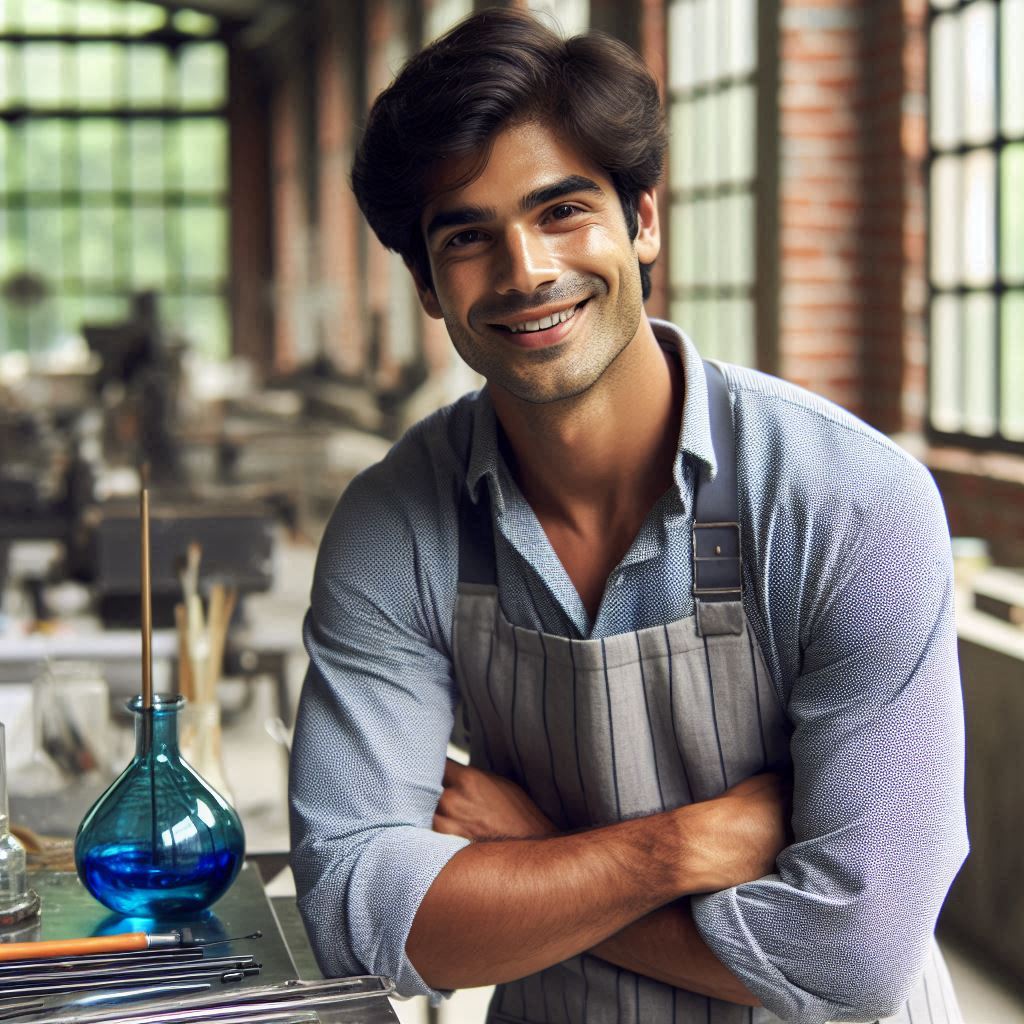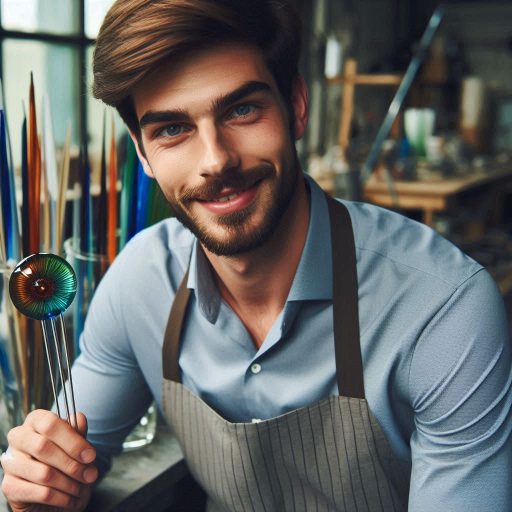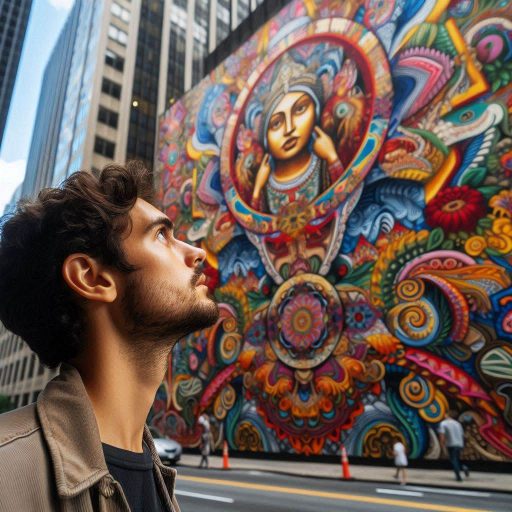Introduction
Glass art captivates audiences with its vibrant colors and intricate designs.
It holds a significant place in the art world, blending craftsmanship with creativity.
Artists have long valued glass for its unique ability to reflect light and convey emotion.
From functional objects to stunning sculptures, glass art showcases versatility.
The evolution of glass art techniques reflects advancements in technology and artistic expression.
Early glassmakers relied on basic methods, such as blowing and molding, to create simple vessels.
Over centuries, they refined these techniques, introducing more complex forms and decorative elements.
The Renaissance marked a turning point, as artisans began experimenting with stained glass in cathedrals, elevating its status as an art form.
In the 20th century, innovations transformed glass art even further.
Artists began exploring methods like fusing, casting, and cold working, expanding the medium‘s possibilities.
Contemporary glass artists push boundaries, integrating mixed media and conceptual ideas into their work.
These innovations allow for greater expression and experimentation, attracting a new generation of artists.
Today, glass art continues to evolve, influenced by technology and collaboration.
Artists embrace digital tools and sustainability, reshaping how they create and present their work.
The significance of glass art lies not only in its beauty but also in its ongoing journey of innovation.
As techniques advance, so does the dialogue between tradition and modernity in this captivating medium.
History of Glass Art
Origins of Glass Art
Glass art has been a form of expression for centuries, dating back to ancient civilizations such as Mesopotamia and Egypt.
Development and Milestones
The Romans perfected glassblowing techniques in the 1st century BC, revolutionizing the art form.
The Renaissance period saw a resurgence in glass art, with intricate stained glass windows and decorative glassware.
Industrial Revolution Impact
The Industrial Revolution brought mass production of glass, making it more accessible to artists and craftsmen.
Transform Your Career Today
Unlock a personalized career strategy that drives real results. Get tailored advice and a roadmap designed just for you.
Start NowInnovations in glassmaking techniques, such as lampworking and fusing, opened up new possibilities for artists.
20th Century Innovations
Artists like Dale Chihuly pushed boundaries with large-scale glass installations and sculptural pieces.
Studio glass movement emerged in the mid-20th century, emphasizing individual creativity and experimentation.
Contemporary Glass Art
Today, glass artists continue to push the boundaries of the medium with innovative techniques and new technologies.
Collaborations between artists, scientists, and engineers have led to groundbreaking advancements in glass art.
Read: Interview with a Professional Glass Artist
Traditional Glass Art Techniques
Connon traditional glass art techniques
When it comes to traditional glass art techniques, there are several methods that have been practiced for centuries.
These techniques require skill, precision, and creativity to produce stunning works of art.
Let’s explore some of the most popular traditional glass art techniques:
Blown Glass
Blown glass is a technique that involves inflating molten glass into a bubble using a blowpipe.
This method allows artists to create intricate shapes and designs by manipulating the hot glass.
Blown glass pieces can range from delicate ornaments to large sculptures, showcasing the versatility of this technique.
Artists often use a variety of tools to shape the glass and add texture or color to their creations.
Stained Glass
Stained glass is a technique that involves assembling pieces of colored glass to create a design or image.
Artists use lead strips to join the glass pieces together, adding strength and structure to the final piece.
Stained glass windows and panels are a common application of this technique, known for their intricate patterns and vibrant colors.
Artists can also incorporate painted details or textures to enhance the visual impact of their stained glass creations.
Fused Glass
Fused glass is a technique that involves melting multiple pieces of glass together in a kiln at high temperatures.
This process allows artists to create unique patterns, textures, and color blends within a single piece of glass.
Fused glass jewelry, plates, and sculptures are popular examples of this technique, showcasing its versatility and beauty.
Transform Your Career Today
Unlock a personalized career strategy that drives real results. Get tailored advice and a roadmap designed just for you.
Start NowArtists can experiment with different types of glass, such as transparent, opaque, or dichroic, to achieve various effects in their fused glass artwork.
The processes involved in each technique and their unique characteristics
Each traditional glass art technique offers a distinct approach to working with glass, resulting in a wide range of artistic possibilities.
Whether it’s the fluidity of blown glass, the precision of stained glass, or the creativity of fused glass, artists continue to push the boundaries of these techniques through innovation and experimentation.
By mastering these traditional methods, artists can create timeless pieces of glass art that captivate and inspire viewers for generations to come.
Read: Sustainable Practices in Glass Art
Contemporary Glass Art Innovations
Modern innovations in glass art have brought about a revolution in the way artists approach their craft.
Techniques such as 3D printing, digital design, and mixed media have pushed the boundaries of traditional glass art, opening up new possibilities for creativity and experimentation.
3D Printing in Glass Art
One of the most exciting developments in contemporary glass art is the integration of 3D printing technology.
Artists can now create intricate designs and sculptures with a level of precision and complexity that was previously impossible.
3D printing allows for the production of unique, one-of-a-kind pieces that showcase the artist’s vision in ways that were not possible before.
This technology has enabled glass artists to experiment with new shapes, textures, and forms, pushing the boundaries of what is considered traditional glass art.
Digital Design Techniques
Advancements in digital design have also had a significant impact on glass art.
Artists can now use computer software to create detailed, complex patterns and designs that can be translated into glass artworks.
Digital design tools allow artists to experiment with colors, shapes, and textures in ways that were previously not possible.
This has opened up a whole new world of possibilities for glass artists, allowing them to create pieces that are truly innovative and unique.
Mixed Media Approaches
Another innovation in contemporary glass art is the incorporation of mixed media techniques.
Artists are now combining glass with other materials such as metal, wood, and ceramics to create stunning, multi-dimensional pieces.
This blending of materials adds depth and texture to the artwork, creating a dynamic visual experience for the viewer.
By incorporating mixed media elements, artists are able to push the boundaries of traditional glass art and create pieces that are truly original and captivating.
In short, the innovations in contemporary glass art, such as 3D printing, digital design, and mixed media approaches, have revolutionized the way artists create and express themselves.
Transform Your Career Today
Unlock a personalized career strategy that drives real results. Get tailored advice and a roadmap designed just for you.
Start NowThese techniques have pushed the boundaries of traditional glass art, allowing for greater experimentation, creativity, and innovation in the field.
As technology continues to advance, the possibilities for glass art are endless, and we can expect to see even more groundbreaking innovations in the future.
Read: Exploring Different Styles of Calligraphy Art

Sustainability in Glass Art
In the world of glass art, sustainability plays a vital role in shaping the industry for a more eco-friendly future.
Let’s delve into the importance of sustainability in the glass art industry and highlight artists and studios that prioritize eco-friendly practices in their work.
Importance of Sustainability in Glass Art
- Reduction of carbon footprint
- Conservation of resources
- Promotion of ethical practices
- Positive impact on the environment
Sustainability in glass art involves using recycled materials, minimizing waste, and adopting energy-efficient techniques.
By incorporating sustainable practices, artists can contribute to environmental conservation while creating stunning pieces of art.
Artists and Studios Prioritizing Eco-Friendly Practices
- Studio 1: Implements a closed-loop system to recycle glass scraps
- Artist 1: Uses reclaimed glass bottles in their creations
- Studio 2: Utilizes solar panels to power their glass furnaces
- Artist 2: Focuses on creating minimalist designs to reduce material waste
These artists and studios serve as inspiring examples of how sustainability can be integrated into the glass art industry.
By championing eco-friendly practices, they not only create beautiful artworks but also set a positive precedent for others to follow.
Read: Famous Calligraphers and Their Iconic Works
Global Influences in Glass Art
When examining glass art, it’s important to recognize the diverse influences that have shaped its techniques and styles around the world.
From ancient traditions to modern innovations, the global impact on glass art is vast and significant.
Cultural Influence on Glass Art
- Ancient Egypt: Glassmaking techniques were developed, including the use of molds and colorants.
- Renaissance Italy: Murano glassblowing techniques revolutionized the art form with intricate designs.
- Japanese Art: Minimalistic and delicate glass art styles influenced by Zen philosophy.
Cross-Cultural Collaborations
Modern glass artists often collaborate with artists from different cultural backgrounds to create unique pieces.
Exchanges in techniques and styles lead to innovative approaches and the blending of traditional and contemporary elements.
Artists from diverse cultures share ideas, materials, and methods to push the boundaries of glass art.
Global influences in glass art not only enrich the field but also promote cultural exchange and mutual understanding.
By embracing cross-cultural collaborations, artists can explore new possibilities and expand their creative horizons.
Explore Further: Case Studies: Successful Product Design Projects
Emerging Trends in Glass Art
As the world of art continues to evolve, glass art is also experiencing new trends that are pushing boundaries and redefining the traditional perceptions of the medium.
These emerging trends are not only innovative but also play a crucial role in shaping the future of glass art.
Transform Your Career Today
Unlock a personalized career strategy that drives real results. Get tailored advice and a roadmap designed just for you.
Start NowCurrent Trends in Glass Art
- Interactive Installations: Artists are creating interactive glass installations that engage viewers on a sensory and emotional level.
These installations often incorporate technology to enhance the viewer’s experience. - Light Art: Light has become a central element in many contemporary glass art pieces.
Artists are using light to create dynamic and mesmerizing effects within their glass creations, adding a new dimension to the medium. - Kinetic Sculptures: Another trend in glass art is the creation of kinetic sculptures that move and change shape.
These sculptures showcase the versatility of glass as a medium and challenge the traditional notions of static art.
Shaping the Future of Glass Art
These current trends in glass art are not just passing fads but are revolutionizing the way artists approach and work with the medium.
By pushing the boundaries of traditional glassmaking techniques and embracing innovation, these trends are shaping the future of glass art in several ways.
Firstly, interactive installations are creating a more immersive and engaging experience for viewers, blurring the lines between art and audience.
This level of engagement not only captivates viewers but also challenges them to interact with art in a new and exciting way.
Secondly, the use of light in glass art adds a new layer of depth and complexity to pieces, making them visually striking and captivating.
Artists are exploring the possibilities of light as a medium in itself, creating dynamic and ever-changing artworks that evolve with the lighting conditions.
Lastly, kinetic sculptures are pushing the boundaries of what is possible with glass as a medium.
The movement and transformation of these sculptures create a sense of wonder and awe, captivating audiences and showcasing the versatility and adaptability of glass art.
Overall, these emerging trends in glass art are not only shaping the future of the medium but also challenging traditional notions of what glass art can be.
By embracing innovation and pushing boundaries, artists are creating unique and mesmerizing artworks that captivate audiences and inspire new generations of artists to explore the possibilities of glass as a medium.
Famous Glass Artists and Their Work
Dale Chihuly
- Renowned for his innovative glass sculptures
- Known for his large-scale installations in public spaces
Impact
- Transformed glass art from traditional craft to contemporary art form
- Pioneered new techniques in glass blowing and manipulation
Lino Tagliapietra
- Master glassblower from Murano, Italy
- Influenced by Venetian glass traditions and modern design
Impact
- Elevated glassblowing to a fine art form
- Blends traditional techniques with modern aesthetics
Tina Aufiero
- Mixed media artist specializing in glass and ceramics
- Known for her intricate and delicate glass sculptures
Impact
- Explores themes of nature and fragility through her work
- Pushes the boundaries of what is possible with glass as a medium
Stanislav Libensk‘ and Jaroslava Brychtov‘
- Czech husband-and-wife duo known for their monumental glass sculptures
- Collaborated on many large-scale installations around the world
Impact
- Introduced the concept of glass as a sculptural material
- Combined traditional glass techniques with modernist aesthetics
David Patchen
- Contemporary glass artist based in San Francisco
- Specializes in intricate glass vessels and sculptures
Impact
- Known for his vibrant color combinations and meticulous detail
- Pushes the boundaries of traditional glassblowing techniques
These artists have not only pushed the boundaries of what is possible with glass as a medium but have also redefined the field of glass art as a whole.
Their works continue to inspire and captivate audiences around the world, showcasing the beauty and versatility of glass as an art form.
Conclusion
In this blog post, we explored various techniques and innovations in the world of glass art.
From kiln-formed glass to glass blowing, we learned about the versatile ways artists can create stunning pieces.
The use of technology such as CNC machines and 3D printing has opened up new possibilities in glass art, allowing for intricate designs and shapes to be brought to life.
Artists are constantly pushing the boundaries of what is possible with glass, resulting in breathtaking sculptures, installations, and functional objects.
The evolution of glass art continues to be a dynamic and exciting field.
As materials and techniques advance, the potential for creativity and expression in glass art is limitless.
Encouraging readers to support and explore this unique art form is crucial to its ongoing success and innovation.
Whether you’re a seasoned collector or a newcomer to the world of glass art, there is always something new to discover and appreciate.
Transform Your Career Today
Unlock a personalized career strategy that drives real results. Get tailored advice and a roadmap designed just for you.
Start NowBy staying informed and showing your support for glass artists, you can help ensure that this beautiful art form continues to thrive and inspire for years to come.
[E-Books for Sale]
The Big Book of 500 High-Paying Jobs in America: Unlock Your Earning Potential
$19.99 • 500 High-Paying Jobs • 330 pages
Explore 500 high-paying jobs in America and learn how to boost your career, earn more, and achieve success!
See All 500 High-Paying Jobs of this E-Book
1001 Professions Without a Degree: High-Paying American Jobs You Can Start Now
$19.99 • 1001 Professions Without a Degree • 174 pages
Discover 1001 high-paying jobs without a degree! Unlock career tips, skills, and success strategies for just $19.99!




